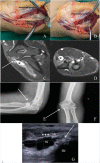Intraneural or extraneural ganglion cysts as a cause of cubital tunnel syndrome: A retrospective observational study
- PMID: 35989915
- PMCID: PMC9388826
- DOI: 10.3389/fneur.2022.921811
Intraneural or extraneural ganglion cysts as a cause of cubital tunnel syndrome: A retrospective observational study
Abstract
Purpose: Cubital tunnel syndrome caused by ganglion cysts has rarely been reported. The purpose of this study was to evaluate the surgical treatment outcomes of a patient diagnosed with cubital tunnel syndrome caused by intraneural or extraneural cysts and to summarize our experience.
Method: In total, 34 patients were evaluated retrospectively from January 2011 to January 2020 with a follow-up of more than 24 months. Preoperative data, such as demographic data, clinical symptoms, physical examination findings, and laboratory tests, were all recorded and pre-operative and post-operative data were compared. The function was evaluated by the modified Bishop scoring system and the McGowan grade at the last follow-up.
Results: Improvement of interosseous muscle strength, the Visual Analog Scale (VAS), 2-point discrimination (2-PD), electromyogram (EMG) result, Wartenberg sign, claw hand, and weakness could be clearly observed in all patients. Extraneural cysts were completely removed and the pedicles of the cysts were ligated. Intraneural cysts were incised and drained, and part of their cyst walls were removed using a microsurgical technique. All patients underwent anterior subcutaneous transposition (AST). At the last follow-up, McGowan's (0-IIa) grade increased from seven patients (20.6%) preoperatively to 27 patients (79.4%); the excellent and good rate according to the modified Bishop scoring system was 82.4% (28 patients), and all patients had no symptoms of recurrence after surgery.
Conclusion: The treatment of cubital tunnel syndrome caused by intraneural or extraneural cysts achieved good long-term results through extraneural cyst resection or intraneural cyst incision and drainage combined with subcutaneous transposition. Early diagnosis and surgical treatment are essential for the patient's postoperative recovery.
Keywords: anterior subcutaneous transposition (AST); cubital tunnel syndrome; ganglion cysts; surgical management; ulnar nerve.
Copyright © 2022 Yalikun, Yushan, Hamiti, Lu and Yusufu.
Conflict of interest statement
The authors declare that the research was conducted in the absence of any commercial or financial relationships that could be construed as a potential conflict of interest.
Figures


Similar articles
-
Cubital tunnel syndrome caused by ganglion cysts: a review of 59 cases.Acta Neurochir (Wien). 2017 Jul;159(7):1265-1271. doi: 10.1007/s00701-017-3180-6. Epub 2017 Apr 19. Acta Neurochir (Wien). 2017. PMID: 28424917
-
The cubital tunnel syndrome caused by the intraneural or extraneural ganglion cysts: Case report and review of the literature.J Plast Reconstr Aesthet Surg. 2017 Oct;70(10):1404-1408. doi: 10.1016/j.bjps.2017.05.006. Epub 2017 Jul 6. J Plast Reconstr Aesthet Surg. 2017. PMID: 28803901
-
Cubital Tunnel Syndrome Due to Intraneural Ganglion Cysts of the Ulnar Nerve With Joint-Cyst Connection at the Elbow.Neurosurgery. 2024 Nov 1;95(5):1055-1063. doi: 10.1227/neu.0000000000002975. Epub 2024 May 3. Neurosurgery. 2024. PMID: 39733297
-
Ulnar intraneural cysts as a cause of cubital tunnel syndrome: presentation of a case and review of the literature.Eur J Orthop Surg Traumatol. 2019 Oct;29(7):1559-1563. doi: 10.1007/s00590-019-02475-7. Epub 2019 Jun 21. Eur J Orthop Surg Traumatol. 2019. PMID: 31222541 Review.
-
Cubital tunnel syndrome - a review and management guidelines.Cent Eur Neurosurg. 2011 May;72(2):90-8. doi: 10.1055/s-0031-1271800. Epub 2011 May 4. Cent Eur Neurosurg. 2011. PMID: 21547883 Review.
Cited by
-
Ulnar Neuropathy Caused by a Giant Epidermal Cyst at the Elbow: Case Report.NMC Case Rep J. 2024 Jul 27;11:187-190. doi: 10.2176/jns-nmc.2024-0019. eCollection 2024. NMC Case Rep J. 2024. PMID: 39183797 Free PMC article.
References
LinkOut - more resources
Full Text Sources

